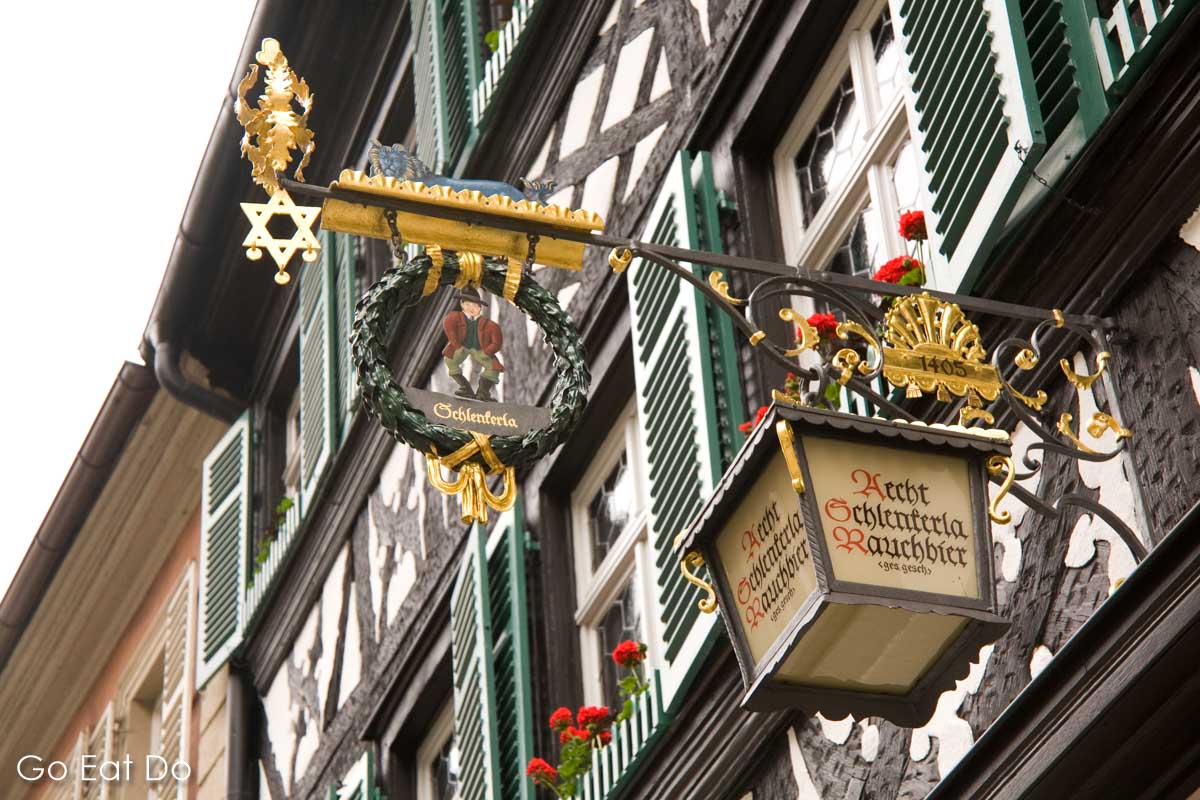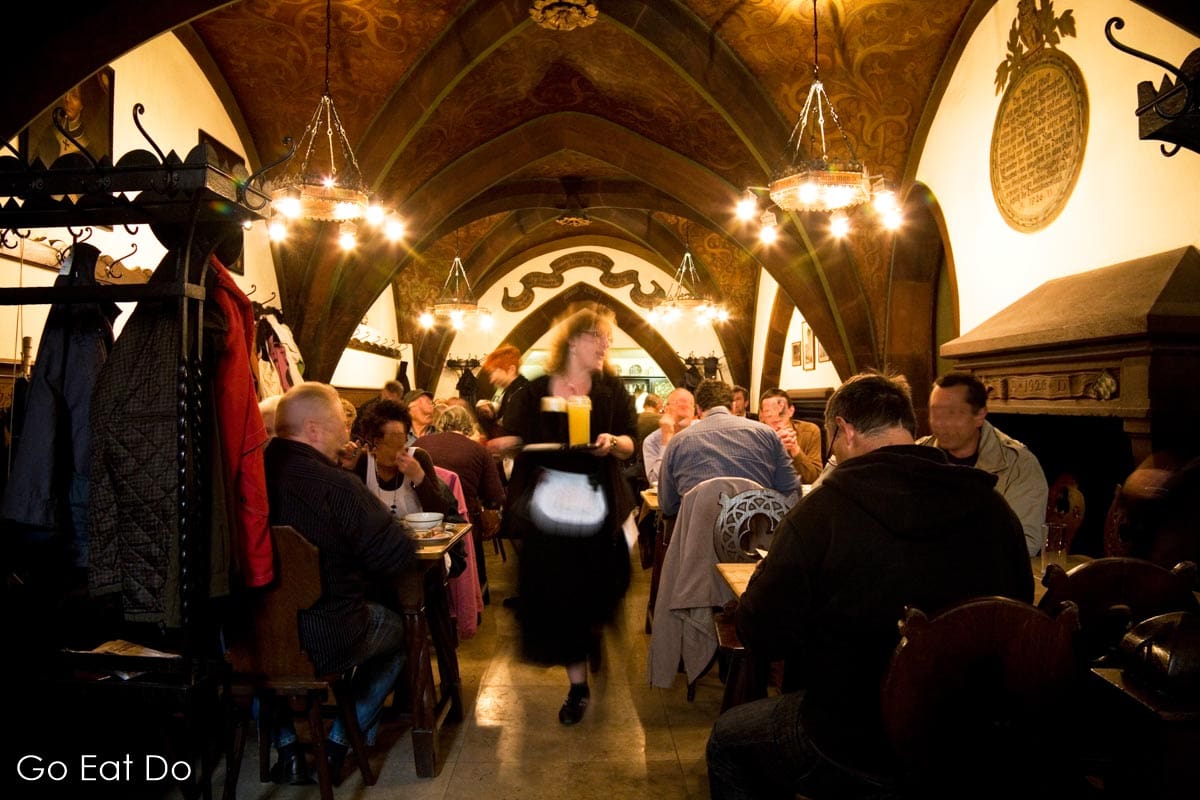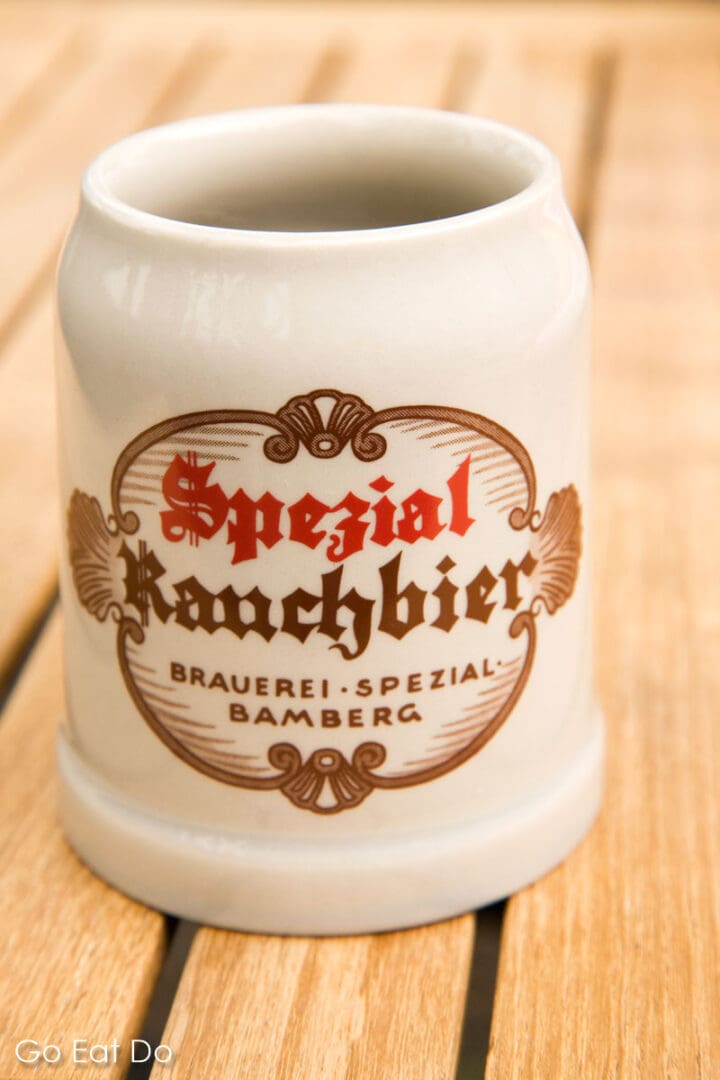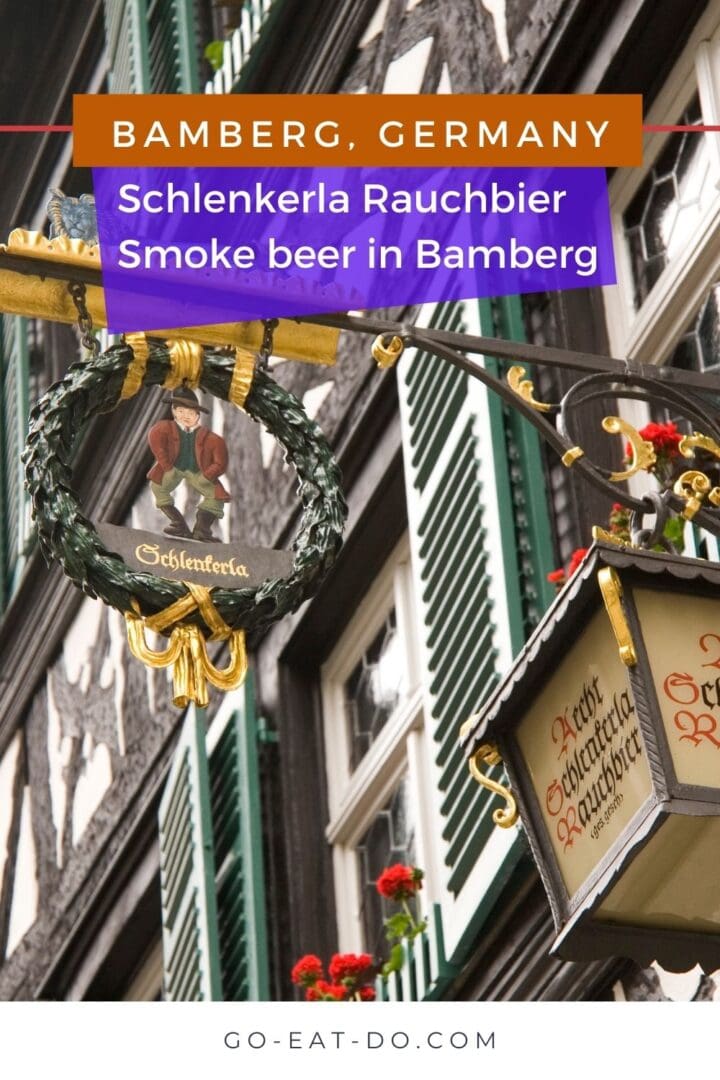Stuart Forster travels to the Franconia region of northern Bavaria to taste Schlenkerla Rauchbier, smoke beer in Bamberg, Germany.
Disclosure: Some of the links below and banners are affiliate links, meaning, at no additional cost to you, I will earn a commission if you click through and make a purchase.
The well-preserved medieval core of Bamberg is the European Union’s third largest urban UNESCO World Heritage Site. Bamberg Cathedral holds the tomb of the only pope buried north of the Alps. The architecture of Bamberg means there’s lots to do and see in the heart of this historic city. Yet culture and history can wait, I came here for a beer.
I just spent nearly two hours travelling north to Bamberg on a train from Munich. They know how to brew decent beer in Bavaria’s state capital too. But I want to sample Schlenkerla Rauchbier in the historic tavern that bears the brewery’s name.

Schlenkerla Rauchbier in Bamberg
Rauchbier means ‘smoked beer’. In recent years finding bottles outside of Franconia has become increasingly easy thanks to specialist beer stores and pubs now stocking it. A few years ago it used to be unusual to see Schlenkerla Rauchbier stocked outside of a 50-kilometre radius of Bamberg.
It’s now possible to purchase Aecht Schlenkerla Rauchbier online from beer stockists and Amazon:

Schlenkerla Rauchbier is also available in five-litre kegs:

The Schlenkerla Bamberg tavern
Unlike many German cities, Bamberg survived World War Two largely intact. Rich in character, many of the city’s medieval buildings have been restored in recent years. The building in which the Schlenkerla Tavern is housed dates from 1405. It was originally part of a Dominican monastery.
An ornate, wrought iron sign hangs over the street outside of the tavern. Once inside I’m impressed by how busy it is for a midweek afternoon. I take a seat by a heavy wooden table under the Gothic vaulted ceiling and enjoy the convivial ambience of people conversing.
A waitress wearing a traditional Dirndl dress brings my glass of red-brown Rauchbier. I savour the beer’s complex, smoky aroma before taking a sip. Schlenkerla Rauchbier is genuinely smoky in flavour. It’s strong but not overly intense; I’m impressed.

Bamberg breweries and brewing heritage
Bamberg is a city with an unparalleled beer brewing culture. The Benedictine monastery on the Michaelsberg, a short walk from where I sit, received its brewing rights in 1122. Today that site is the home to the Franconian Brewery Museum. 70,000 people live in Bamberg, which supports nine breweries brewing more than 50 different beers.
Matthias Trum, Schlenkerla’s General Manager, arrives and greets me. He quickly explains the significance of brewing in this region: “Bamberg is in the heart of Franconia. In an area about the size of Greater London, there are more than 200 breweries here. There’s one brewery for every 5000 people. This is the highest brewery density in the world. Every village has a church and one or two breweries.”

Hiking and cycling in Franconia
“Hiking and bicycle tours, from village to village, are popular in Franconia during summer. Some of the breweries have been around for centuries and have traditional recipes…there are something like 15 different styles, including regular style pilsners, smoked beers, cellar beers, Ungespundetes [beer matured in a wooden barrel, with less carbon dioxide than is standard beer], and wheat beers, so if you have the time sample some of those,” adds Matthias.
I nod enthusiastically and like the idea of the research that I’ll be undertaking over the next couple of days.
While chatting to Matthias I learn that the brewing techniques employed by Schlenkerla are essentially unchanged from those of six generations ago when his forefathers entered the brewing industry. Beechwood cut from Franconian forests is used during the malting process to give Schlenkerla smoke beer its characteristic smoky flavour.
Brewing smoked beer
“We produce all our malt ourselves for the smoked beer…in the malting process the grain needs to be dried, this process is called kilning. Kilning in central Europe, where it is moist most of the time, can only be done over an open fire. Imagine a fireplace with a chimney and, on top of that, you have a storage facility where you put the wet barley. Now the heat and the smoke from the fire rise up and dry the malt in the kiln, the smoke penetrates the malt gives the smoky aroma and flavour,” he says.
“The historical background is important to us. I don’t want to produce a fashionable beer. All that we are doing here at Schlenkerla has been around for centuries. There’s a reason why we are doing it. We are doing it because our ancestors did it like that and we want to uphold the tradition and preserve the old technology by kilning the malt over logs,” explains Matthias passionately.
The oldest record of the Schlenkerla brewery dates from 1678, but it’s likely it was founded even before then.
History of brewing in Germany
“You know, from 1618 to 1648 there was the Thirty Years War and if you look at the founding date of German breweries you’ll see many were founded between 1648 and 1700. This is for two reasons,” says Matthias.
“First of all, a lot of cities were rebuilt after the war and the second thing is existing operations got their brewing rights re-issued. Very often when a foreign army attacked the city they would burn down the city hall, where all the documents were stored of course. From today’s point of view it’s often difficult to say whether a brewery was newly opened or an old one with a new document,” he adds.
I take another sip of my beer, which is poured from wooden barrels a few metres from where I’m sitting. The brewery is just 10 minutes’ walk away.

Schlenkerling home after a beer
I ask about the name of the pub in which we’re sitting. Matthias answers by pointing to the figure of a man with a walking stick on one of the beer mats on the table. “Schlenkerla means to sway or swagger in Franconian vernacular. According to legend, my ancestor had an accident in the brewery. After that, he had to use a stick and the regulars, the people from the Stammtisch, called him the Schlenkerla (“the little swaggerer”) as a nickname. It became proverbial and people said, “let’s go to Schlenkerla”. People sometimes think if they drink enough of it they’ll swagger themselves,” he jokes.
As I’ve learned over the past few minutes, having a beer can sometimes provide insights into a city’s heritage.
Map of Schlenkerla in Bamberg
The map of Bamberg, below, depicts the location of the Schlenkerla tavern on Domanikaner Strasse:
Hotels in Bamberg
Looking for accommodation in Bamberg? Search for hotels in Bamberg’s city centre via Booking.com:
Booking.com
Travel to Bamberg
Bamberg is a 230-kilometre drive north along the A9 from Munich, the location of Munich Airport. Germany’s Inter-City Express (ICE) trains represent an efficient and relaxing way of travelling between the two cities.
Nuremberg Airport is approximately 60 kilometres (37 miles) south of Bamberg on the A73.
From Frankfurt Airport, Bamberg is a 216-kilometre (134-mile) drive along the A3 and A70.
Books about beer and Germany
Planning a trip to Bamberg or simply have an interest in beer? You may find the following books interesting:
The Brewer’s Tale: A History of the World According to Beer by William Bostwick:





Further information
Visit the Schlenkerla website for more information about the brewery, Schlenkerla smoked beer and to see up-to-date opening times of the tavern on Dominikaner Strasse in Bamberg, Germany.
Discover things to do and see in and around the city on the Bamberg and Germany tourism information websites.
Thanks for visiting Go Eat Do and reading this post about Schlenkerla smoke beer in Bamberg, Germany. Planning a trip to Bamberg? You may enjoy listening to classical music played in Bamberg as part of the Gustav Mahler Conducting Competition. If you enjoy reading about the history of beer please stay on Go Eat Do to check out this post about the beer purity law known as the Bavarian Reinheitsgebot of 1516.
Stuart Forster, the author of this post, is a member of the British Guild of Beer Writers. He has lived in Germany and speaks fluent German.
If you enjoyed this post why not sign up for the free Go Eat Do newsletter? It’s a hassle-free way of getting links to posts on a monthly basis.
‘Like’ the Go Eat Do Facebook page to see more photos and content.
A version of this post was first published on Go Eat Do on 16 July 2013.



